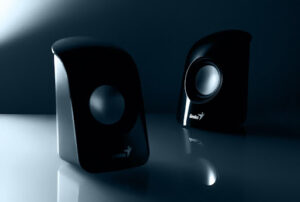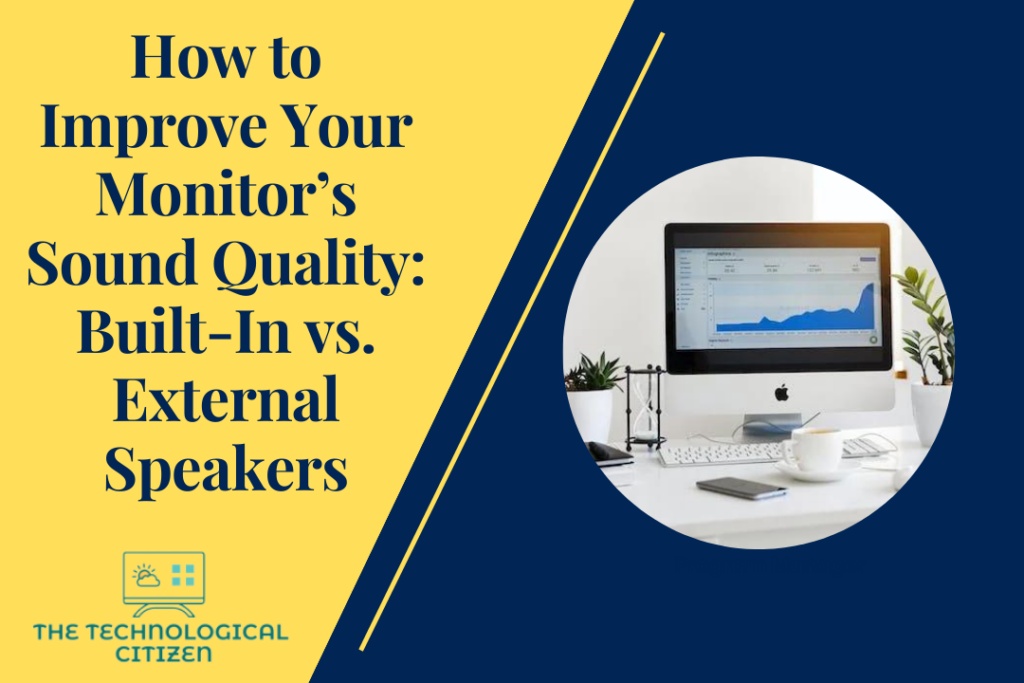Many computer users struggle with quality issues regarding monitor audio. Some monitors may not have an impressive built-in speaker and, thus, may provide an underwhelming audio performance.
But many other high-quality monitor models provide the best built-in speakers. Even if you don’t have a monitor with good in-built speakers, you can always enhance the audio by adding suitable external speakers.
The article below explains the pros and cons of monitors with built-in speakers and external speakers. It also provides insights on how to improve your monitor’s sound quality.

Is it better to get a monitor with built-in speakers?
There are positives and negatives to purchasing a monitor with built-in speakers. As the quality of the built-in speakers depends entirely on the monitor model, a general opinion on this topic is not possible to make.
Pros of buying a monitor with built-in speakers
1. Ideal for basic use
Not everyone uses a monitor or computer system for advanced requirements. A significant part of the population uses computers for basic and general purposes. So, a specialized set of external speakers will be unwanted for such users.
Monitors with built-in speakers are the best options for those users. Such models enable the basic users to not spend any more money on external speakers for little to no use.
2. Space-saving
Monitors with built-in speakers are the best options if you have a space-saving requirement in mind. As they come with no extra hardware, you can have ample space on your desktop.
3. No extra cost
As monitors with built-in speakers have no additional accessories, maintenance costs could be much lower. You need not spend money on purchasing or maintaining a set of external speakers.
4. Controlling is easy
When using internal speakers on a monitor, you can easily control them with minimal instructions. As the control panel of these speakers is incorporated within the monitor, you need not follow any complicated steps or use any extra tools to control them.
5. Portability
In-built monitor speakers are handy when porting the system to another location. If you have extra accessories like external speakers or amplifiers, transportation could get relatively tricky.

Cons of buying a monitor with built-in speakers
1. Average sound quality
One of the most common criticisms that monitors with in-built speakers face is their average sound quality. As the speakers are within the monitor, certain limitations exist with the quality of sound they can produce.
Most of these models lack in bass section also. The sound quality and bass issues cause listening to music to be a bit underwhelming with these monitor models.
2. Monitor size may be high
It is usually visible that monitors with built-in speakers come off as a bit too bulkier than regular monitors. These monitors have to fit in the speaker hardware within them, and this is why their size tends to get larger.
At present, most computer users prefer sleek monitor models for their aesthetics and convenience. So, a bulky monitor model might not appeal well to the users.
3. Lack of stereo sound
Monitors with built-in speakers have been found to be lacking the ability to produce stereo sound. Stereo Sound is famous for the high-quality listening experience that they provide the users. An absence of stereo sound is a significant disadvantage.

How can I improve the sound quality of my monitor with speakers?
You can improve the sound quality of any monitor by adding one or more external speaker devices to it. These speakers enhance the sound signal created by the monitor without losing its original quality.
Based on the purpose and design, many various speakers are available for monitors. Some of them are:
- Floor-standing speakers
- Subwoofers and surround sound speakers
- Centre speakers
- LCR speakers
- In-ceiling and in-wall speakers
- Bookshelf speakers
Advantages of External Speakers
There are many benefits of using external speakers for monitors. Some of the important ones are:
- Speakers amplify the audio signals for everyone to hear correctly.
- It is much easy to connect between a computer system and an external speaker.
- Due to the amplified sound, multiple users can benefit from speakers.
- Speakers make interactive sessions like online learning more effective.
- Speakers are beneficial while making presentations online.
- Audio-to-text and vice versa software function better with good external speakers.
- New additions like Bluetooth speakers eliminate the clutter caused by wires and cables.
- New models of external speakers are compact enough to port from one place to another conveniently.
Disadvantages of External Speakers
- External speakers mostly play at a relatively higher noise, even in their lowest setting. This could cause practical issues for the users.
- Connectivity problems are pretty standard for Bluetooth and other wireless speakers.
- External speakers cost a reasonable sum of money. More money would have to be spent on the future maintenance of the speakers.

How to connect external speakers to your monitor?
There are multiple ways present to connect external speakers to your monitor. You can use each of these methods based on the model of the speaker and the monitor.
Method 1: Direct Connection
This method works best for monitors that come with a speaker or audio output ports. You can use these output ports to connect any external audio devices.
Step 1: Use a suitable cable compatible with the monitor and the speaker.
Step 2: Tilt the monitor and reach for the audio ports.
Step 3: Insert the cable jack into the correct port and ensure the connection is secure and tight.
Step 4: Use the other end of the cable to connect it to the speaker. Ensure the jack is inserted correctly into the speaker’s input port.
By now, the speaker would start working. If you find the speaker not working, You would have to go to the monitor’s audio settings and the Manage Audio Devices option to find the connected device and manually enable it.
Method 2: Bluetooth Connection
If your monitor supports Bluetooth devices like speakers, you can connect them to your monitor using the following method.
Step 1: Turn on the speaker and enable the Bluetooth feature.
Step 2: Switch on the monitor, go to its Bluetooth settings, and enable Bluetooth.
Step 3: Now, the screen will show many available Bluetooth devices around. Find the name of your Bluetooth speaker from the list and choose it to connect with the monitor.

Summary
Audio quality is one of the determining factors of a computer system. Monitors and computers are available with two kinds of sound systems: internal and external. Monitors with internal audio systems have built-in speakers, whereas monitors with external audio systems would have to use external speakers to produce sound.
Both built-in speakers and external speakers have their share of pros and cons. While built-in speakers offer high convenience and controlling power for the users, external speakers provide better sound quality. The deciding factor between these two options should ultimately be the audio preferences of the user.
FAQs
1. Are monitor speakers necessary?
The audio system is an inevitable part of any monitor. Monitors can have built-in or external speakers. But it is essential for them to have one of the two, as monitors with no audio system do not provide much use to the buyer.
2. Do monitor speakers need a subwoofer?
Subwoofers are not essential when it comes to monitor speakers. If you don’t have advanced audio needs like music production, you need not use a subwoofer for your monitor speaker.

